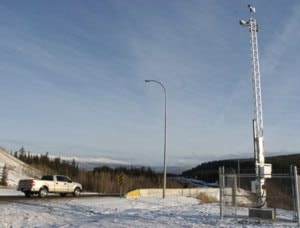High-tech weather stations fitted with cameras and sensors have been installed at three points along the Alaska Highway to monitor road conditions.
Highways staff will retrieve data from the stations over a number of years and use it to figure out how to maintain the highways.
They’re part of a program to make the territory’s highways safer, said Yukon transportation planning and programming manager Wally Hidinger.
The monitors will give the territory’s maintenance workers advance warning about the highway’s problem areas.
When there’s ice, they’ll be able to get sand and anti-icing agents out on the road more quickly, he added.
The stations are fitted with detectors drilled into the ground that measure the air temperature, road temperature and underground temperature.
Sensors also determine the wind speed and direction, the relative humidity and snow depth in the area.
The stations are fitted with still cameras that snap photographs of the highway every 20 minutes to give researchers “visual confirmation” of the sensors’ data.
“A picture is worth a thousand words and several thousand numbers,” said Hidinger.
Currently, there are three stations around Whitehorse in places that regularly ice up — one near Rabbit’s Foot Canyon, one in the dip by Meadow Lakes Golf Club and a third by Lone Moose Lane near Marsh Lake.
Each spot has unique road conditions that can prove dangerous for drivers.
And each spot sees a lot of traffic.
The stations cost about $100,000 each.
They are jointly funded by the Yukon government and Transport Canada’s strategic highway infrastructure program.
The governments split the bill.
Currently the stations are part of a pilot project, but the program may expand to other problem areas in the Yukon depending on the results from the first batch.
Although none of the sites are active yet, Hidinger hopes to receive the first data in 10 days and that all will be fully operational by Christmas.
